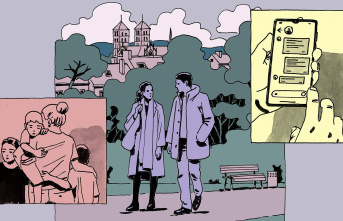Always on the go - that's the impression you get when you look at Thomas Hoepker's photographs. He has been showing the world as it is for 70 years. The list is long: China, Portugal, Italy, he was also in the GDR at the time of the Iron Curtain. He spent three years there, capturing life in photographs. He met legends like Muhammad Ali several times, which is how famous pictures of the boxing icon came about. Everyone knows Thomas Hoepker's paintings, and they can currently be seen in the Ernst Leitz Museum in Wetzlar. There are also photographs from his student days that have never been shown before. There's a new book that's like time travel across America, and there's a movie about the 85-year-old coming out soon. Thomas Hoepker, who suffers from Alzheimer's, answers the questions that ntv.de put to him in writing after a meeting in the Wetzlar Museum, together with his wife Christine Kruchen. It's about exciting road trips, the scary disease Alzheimer's, shoes, dogs and humor.
ntv.de: How did your first road trip to the USA come about in 1963?
Thomas Hoepker: I was 27 at the time and worked for the magazine "Kristall", which was published every 14 days. One day the editor-in-chief asked if I would like to discover America. The author Rolf Winter and I didn't have to think long. Our route was succinctly outlined: "Fly to New York, rent a car, head towards the Pacific and take a different route back. Take photos along the way and write down what you see." There was no exact time specification. We liked the brief briefing.
Why did you embark on this journey again in 2020?
I've been on the road a lot in the last few decades. However, mostly outside the USA, where I have lived permanently since 1977, with a short break. Somehow there was never much time between all the orders to cross the USA again and without time pressure. The opportunity arose in early 2019 when the Hamburg director and producer Nahuel Lopez approached me with the idea for a cinema documentary. He asked what I would like to do again. I didn't have to think long about it.
In contrast to those from 1963, no people can be seen in the new pictures ...
It wasn't a conscious decision. I was and am a photographer who likes to photograph people. In the spring of 2020, almost no one was out and about, neither in the cities that we wanted to avoid anyway because of the higher risk of infection, nor in the national parks or smaller towns. Even the Las Vegas Strip lay deserted in the afternoon sun.
These empty landscapes in the exhibition are striking. How has your visual language changed over the decades?
Apart from the mostly empty landscapes, I didn't find many interesting subjects on our 2020 road trip. I'm not a photographer who specifically photographs desolate rows of houses, abandoned gas stations or lonely water towers. On the other hand, I have repeatedly photographed interesting, impressive landscapes on my travels, especially when something "poisoned" the perfect view.
What is your favorite subject?
People in everyday situations who catch my eye because of something, be it a special hairstyle, styling and so on. But also museum visitors and their interactions with art. Humorous, ironic moments of all kinds and with growing enthusiasm I like to photograph dogs, probably because we have had one ourselves for 10 years.
How was it for you and your wife, Christine Kruchen, to go on a road trip with a film crew two years ago? Basically, you traveled with strangers in your luggage for six weeks.
We all got along very well, despite the difficult circumstances. After two days they were no longer strangers. Of course, as a photographer, you never like it when someone is constantly glued to your neck, but the team has made themselves almost invisible. And since my wife and I used to make films ourselves, this was not new territory for us.
Is America still the country of your dreams, have you lived in New York for a long time?
Was America ever the country of my dreams and does such a country even exist? It was and is an interesting, exciting, huge country that you have to deal with constantly. It's never boring. That's exactly what we wanted when my then wife Eva Windmöller and I said in 1977 after three years in the GDR that we would like to move to New York. I still love this city and wouldn't want to live in any other.
What do you miss the most when you travel today?
A certain lightness, simplicity in air travel. After 9/11 everything got tighter and now the pandemic-related regulations are added to that. Meanwhile, I admire people who voluntarily take on all this to travel to distant countries.
What is your most important tool?
My advice has always been: If you want to find and take good pictures, you need good shoes. Of course also a reliable camera, of which there are many nowadays and in all price ranges.
You describe yourself as an image manufacturer, but that doesn't mean that you produce images like an assembly line, does it?
No, definitely not, after all, good motifs don't appear on every corner, you have to hike them up. You need a lot of patience. My motto used to be: "I'm not an artist. I'm an image manufacturer!" My pictures were mainly created as a contract photographer, which for decades were only made for a fleeting existence on magazine pages, and which have mostly led a drawer existence in the archive since then.
Her world is increasingly disappearing as a result of the illness. Your self is being stolen from you a little more every day - do the photographs and your archive help you to search for clues and thus keep memories alive?
Without a doubt, that helps me. Constantly dealing with my digital photo catalog brings back memories. On the other hand, I still like to take pictures when the opportunity arises. I think that helps me too.
Alzheimer's makes everyday life more difficult for 36 million people. How did you realize you were terminally ill?
Well, the usual signs started appearing years ago. I kept forgetting names. Otherwise, I haven't noticed any major changes or limitations for many years. I was never really aware that I was terminally ill. That probably has something to do with the fact that my wife and I are a well-rehearsed team and she caught a lot of what I was no longer able to do.
How does knowing you have Alzheimer's affect you and your family?
As strange as that sounds, you somehow learn to deal with it. It's all a little more complicated, logical. But we won't let that get us down just yet.
You manage a considerable amount of travel, how do you manage that despite the terrible illness?
Traveling was and is our everyday life and we do it as long as we can. Millions of people are directly or indirectly affected by this disease. A real plague of the elderly and it is incomprehensible that there are still no effective drugs that stop the progression of the disease or at least significantly slow it down.
Humor seems to be one of your important qualities - does it help in everyday life with Alzheimer's?
Absolutely - I can only recommend!
What do you enjoy the most?
My camera, currently a Leica, good food, good wine, a good bed and our dog Clari.
Juliane Rohr compiled the questions for Thomas Hoepker
The exhibition "Thomas Hoepker - Bilderfabrikant" runs until April 17. July at the Ernst Leitz Museum, Am Leitz Park 6 in 35578 Wetzlar
The film "Dear Memories - A Journey with Magnum Photographer Thomas Hoepker" by Nahuel Lopez is scheduled to hit theaters on June 30th
6












